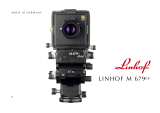Page is loading ...


Specifications
Focal length: 140 mm
Composition: 7 element, 4 group
Angle of view: 35°
Aperture range: f/4.5 - 32
Filter: 77 mm dia. screw-in type
Lens hood: Screw-in type
Length: 3-9/32" (83.5 mm)
Maximum diameter: 3-13/16" (97.2 mm)
Weight: 28.6 oz. (810 g)
So that high resolution can be obtained in the outer edges of
pictures in close-up photography, this lens incorporates the floating
system (device for moving a part of the lens system back and forth to
agree with the in focused distance).
The figure numbers throughout the text refer to pictures on the
fold-out pages at the back.
Names of Parts (Fig. 1)
1. Depth-of-Field Scale
2. Distance scale for Reading Depth-of-Field (with Magnifi
cation and Exposure Compensation scale)
3. Aperture Scale Ring
4. Synchroflash Terminal
5. Time Exposure Lever
6. Mirror-up Socket
7. Floating Ring
Mamiya-Sekor Marco Z 140 mm f/4.5 for Mamiya RZ

Instructions for Use
(1) General photography when an auto extension
tube is not used
Photography Distance: ~ - about 2.5 ft (75 cm) (from film
plane to subject)
1. Align the mark (red) on the floating ring with the central
index mark on the lens barrel (Fig. 2).
2. Focus the camera.
3. Read the bellows extension amount (mm) from the distance
scale on the side of the camera (Fig. 3) and align it with the
scale on the floating ring. (In this case, the white scale
beginning with is used. In this scale, one stop is equivalent
to an extension of 5 mm.).
4. Adjust the focus once more.
* In photographing faraway subjects, adequately sharp images
can be obtained if the floating ring is aligned to When the
floating ring has been operated, always readjust the focus.
(2) When using the auto extension tube No. 1
Photography Distance: About 2.5 ft -1.9 ft (76 cm - 59 cm)
(from film plane to subject)
1. Align the red spot on the yellow No. 1 scale on the floating ring
with the central index mark lens barrel (Fig. 4).
2. Focus the camera.
3. Read the bellows extension amount (mm) from the distance
scale on the side of the camera (Fig. 3) and align it with the
scale on the floating ring. (In this case, one stop is equivalent
to an extension of 5 mm.).
4. Adjust the focus once more.
* If the picture is taken after step 2, an adequately sharp image can
be obtained. When you want maximum sharpness to the outer
edges, carry out steps 3 and 4. In this case, always readjust the
focus.
(3) When using the auto extension tube No-2
Photography Distance: About 2 ft - 1.9 ft (60 cm - 56 cm) (from film
plane to subject)
1. Align the red spot on the white No. 2 scale with the central
index mark on the lens barrel (Fig. 5).
2. Focus the camera.
3. Read the bellows extension amount (mm) from the distance
scale on the side of the camera and align it with the scale on
the floating ring. (In this case, one stop is equivalent to an
extension of 10 mm.).
4. Adjust the focus once more.
* If the picture is taken after step 2, an adequately sharp image
can be obtained. When you want maximum sharpness to the
outer edges, carry out steps 3 and 4. In this case, always
readjust the focus.

(4) When using the auto extension tubes
No. 1 and No. 2 together
Photography Distance: About 1.9 ft - 1.8 ft (57 cm - 56
cm) (from film plane to subject)
1. Align the No. 1+2 red spot on the floating ring with the central
index mark on the lens barrel (Fig. 6).
2. Focus the camera and take the picture.
* In life-size photography, align the bellows extension amount of the
distance scale on the side of the camera to 13 mm. Next, move
the camera itself back and forth to focus. It becomes 1:1. When
photographing the actual size accurately, measure the image on
the ground glass focusing screen and carry out fine adjustments.
Depth-of-Field
If the distance scale ring (2) of the lens is turned and the
photography distance is aligned to the central index mark, it is possible
to read he depth-of-field, magnification and exposure compensation
amount (Fig. 7).
The depth-of-field can be seen on the finder screen if the
depth-of-field preview lever on the lens is pressed down.
Magnification
Magnification is expressed by MAG. The MAG. number is the
inverse of magnification 50 means that the subject is photographed at
1/50 its size, 20 at 1/20 and 5 at 1/5.
Exposure Compensation
The exposure compensation amount is indicated by the STEP
underneath the MAG.
When the STEP number is +0.5, open the aperture by 0.5. when it is
+1, open the aperture by one stop or set the shutter speed to one step
slower. When using a finder which is built-in an exposure meter with
the camera there is no need to make any exposure compensation.
3

How to Read the Close-Up Photography Table
1. The subject distance in this chart indicates the distance
from the outermost edge of the lens to the subject.
2. The values on the left side of each column on the table
are those when an auto extension tube is attached and
the bellows are not extended. The values on the right side of
the column are those when the bellows are extended to the
fullest (46 mm).
4

Depth-of-field Table
140mm
21


/
